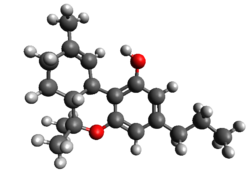Chemistry:Tetrahydrocannabivarin
 | |
 | |
| Clinical data | |
|---|---|
| Routes of administration | Oral, smoked, inhaled |
| ATC code |
|
| Legal status | |
| Legal status |
|
| Identifiers | |
| |
| CAS Number | |
| PubChem CID | |
| IUPHAR/BPS | |
| ChemSpider | |
| UNII | |
| Chemical and physical data | |
| Formula | C19H26O2 |
| Molar mass | 286.415 g·mol−1 |
| 3D model (JSmol) | |
| |
| |
| | |
Tetrahydrocannabivarin (THCV, THV, O-4394, GWP42004) is a homologue of tetrahydrocannabinol (THC) having a propyl (3-carbon) side chain instead of pentyl (5-carbon), making it non-psychoactive in lower doses. It has been shown to exhibit neuroprotective activity, appetite suppression, glycemic control and reduced side effects compared to THC, making it a potential treatment for management of obesity and diabetes.[1] THCV was studied by Roger Adams as early as 1942.[2]
Natural occurrence
THCV is prevalent in certain central Asian and southern African strains of Cannabis.[3][4]
Chemistry
Similar to THC, THCV has 7 possible double bond isomers and 30 stereoisomers (see: Tetrahydrocannabinol). The alternative isomer Δ8-THCV is known as a synthetic compound with a code number of O-4395,[5] but it is not known to have been isolated from Cannabis plant material.

Description
Plants with elevated levels of propyl cannabinoids (including THCV) have been found in populations of Cannabis sativa L. ssp. indica (= Cannabis indica Lam.) from China, India , Nepal, Thailand, Afghanistan, and Pakistan , as well as southern and western Africa. THCV levels up to 20% of total cannabinoids have been reported.[2]
THCV is a cannabinoid receptor type 1 antagonist or, at higher doses, a CB1 receptor agonist and cannabinoid receptor type 2 partial agonist.[6] Δ8-THCV has also been shown to be a CB1 antagonist.[7] Both papers describing the antagonistic properties of THCV were demonstrated in murine models. THCV is an antagonist of THC at CB1 receptors and lessens the psychoactive effects of THC.[8]
THCV also acts as an agonist of GPR55 and l-α-lysophosphatidylinositol (LPI), and beyond the endocannabinoid system, THCV also activate 5-HT1A receptors to produce an antipsychotic effect, that has shown therapeutic potential for ameliorating some of the negative, cognitive and positive symptoms of schizophrenia. THCV furthermore interacts with different transient receptor potential (TRP) channels including TRPV2, which may contribute to the analgesic, anti-inflammatory and anti-cancer effects of cannabinoids and Cannabis extracts. It has also shown anti-epileptiform and anticonvulsant properties, that suggest possible therapeutic application in the treatment of pathophysiologic hyperexcitability states such as untreatable epilepsy.[9]
THCV is found to inhibit the activity of both fatty acid amide hydrolase (FAAH) and monoacyl glycerol lipase (MGL), even at micromolar concentrations, and thereby able to inhibit the hydrolysis of the endocannabinoids anandamide (AEA: C22H37NO2; 20:4, ω-6) besides other N-acylethanolamines and 2-Arachidonoylglycerol (2-AG: C23H38O4; 20:4, ω-6), respectively, therefore, it can also act as an indirect agonist at the cannabinoid receptors, by enhancing the activity of the endocannabinoid system (ECS).[10][11]
Biosynthesis
Unlike THC, cannabidiol (CBD), and cannabichromene (CBC), THCV doesn't begin as cannabigerolic acid (CBGA). Instead of combining with olivetolic acid to create CBGA, geranyl pyrophosphate joins with divarinolic acid, which has two fewer carbon atoms. The result is cannabigerovarin acid (CBGVA). Once CBGVA is created, the process continues exactly the same as it would for THC. CBGVA is broken down to tetrahydrocannabivarin carboxylic acid (THCVA) by the enzyme THCV synthase. At that point, THCVA can be decarboxylated with heat or UV light to create THCV.[12]
Research
Reducing blood sugar
THCV is a new potential treatment against obesity-associated glucose intolerance with pharmacology different from that of CB1 inverse agonists/antagonists.[13] GW Pharmaceuticals is studying plant-derived tetrahydrocannabivarin (as GWP42004) for type 2 diabetes in addition to metformin.[14][better source needed]
Appetite control
THC increases appetite, which is sometimes referred to as "the munchies." THC acts as a CB1 agonist. As a CB1 antagonist, THCV has been shown to reduce appetite in murine models.[15]
Pancreatic cancer
THCV has been demonstrated to show anti-cancer properties in vitro on PANC-1, AsPc-1, HPAF-II, and MiaPaCa-2 cell lines. There is no record of research on in vivo models [16]
Legal status
It is not scheduled by Convention on Psychotropic Substances. In the United States, THCV is not specifically listed as a Schedule I drug, but "Marijuana Extract" is.[17] THCV could be considered an analog of THC, in which case, sales or possession intended for human consumption could be prosecuted under the Federal Analog Act.
United States
THCV is not scheduled at the federal level so long as it is not derived from cannabis varieties that produce more than .3% THC on a dry weight basis in the United States.[18]
The 2018 United States farm bill legalized the production and sale of THCV if it is derived from hemp compliant with the farm bill.[19][non-primary source needed]
See also
- Cannabinoid
- Cannabis
- Cannabivarin (CBV)
- Cannabidivarin (CBDV)
- Federal Analogue Act
- Hexahydrocannabivarin
- Medical cannabis
- Parahexyl
- Rimonabant (synthetic CB1 antagonist)
- Tetrahydrocannabiorcol (Δ9-THCC, (C1)-Δ9-THC)
- Tetrahydrocannabutol (Δ9-THCB, (C4)-Δ9-THC)
- Tetrahydrocannabihexol (Δ9-THCH, (C6)-Δ9-THC)
- Tetrahydrocannabiphorol (Δ9-THCP, (C7)-Δ9-THC)
References
- ↑ "Δ9-Tetrahydrocannabivarin (THCV): a commentary on potential therapeutic benefit for the management of obesity and diabetes". Journal of Cannabis Research 2 (1): 6. January 2020. doi:10.1186/s42238-020-0016-7. PMID 33526143.
- ↑ https://pubs.acs.org/doi/abs/10.1021/ja01255a061
- ↑ "Illicitly imported Cannabis products: some physical and chemical features indicative of their origin". Bulletin on Narcotics 32 (2): 31–40. 1980. PMID 6907024. http://www.unodc.org/unodc/en/data-and-analysis/bulletin/bulletin_1980-01-01_2_page006.html.
- ↑ "A chemotaxonomic analysis of cannabinoid variation in Cannabis (Cannabaceae)". American Journal of Botany 91 (6): 966–75. June 2004. doi:10.3732/ajb.91.6.966. PMID 21653452.
- ↑ "In vivo metabolism of the n-propyl homologues of delta-8- and delta-9-tetrahydrocannabinol in the mouse". Biomedical & Environmental Mass Spectrometry 15 (7): 403–10. April 1988. doi:10.1002/bms.1200150708. PMID 2839261.
- ↑ "The diverse CB1 and CB2 receptor pharmacology of three plant cannabinoids: delta9-tetrahydrocannabinol, cannabidiol and delta9-tetrahydrocannabivarin". British Journal of Pharmacology 153 (2): 199–215. January 2008. doi:10.1038/sj.bjp.0707442. PMID 17828291.
- ↑ "The psychoactive plant cannabinoid, Delta9-tetrahydrocannabinol, is antagonized by Delta8- and Delta9-tetrahydrocannabivarin in mice in vivo". British Journal of Pharmacology 150 (5): 586–94. March 2007. doi:10.1038/sj.bjp.0707124. PMID 17245367.
- ↑ "Evidence that the plant cannabinoid Delta9-tetrahydrocannabivarin is a cannabinoid CB1 and CB2 receptor antagonist". British Journal of Pharmacology 146 (7): 917–26. December 2005. doi:10.1038/sj.bjp.0706414. PMID 16205722.
- ↑ "Tetrahydrocannabivarin" (in en). PubChem. U.S. National Library of Medicine. https://pubchem.ncbi.nlm.nih.gov/compound/93147.
- ↑ "Are cannabidiol and Δ(9) -tetrahydrocannabivarin negative modulators of the endocannabinoid system? A systematic review". British Journal of Pharmacology 172 (3): 737–753. February 2015. doi:10.1111/bph.12944. PMID 25257544.
- ↑ "Efficacy and Safety of Cannabidiol and Tetrahydrocannabivarin on Glycemic and Lipid Parameters in Patients With Type 2 Diabetes: A Randomized, Double-Blind, Placebo-Controlled, Parallel Group Pilot Study". Diabetes Care 39 (10). 2013-09-13. https://diabetesjournals.org/care/article/39/10/1777/129/Efficacy-and-Safety-of-Cannabidiol-and.
- ↑ "Minor Cannabinoids: Biosynthesis, Molecular Pharmacology and Potential Therapeutic Uses". Frontiers in Pharmacology 12: 777804. 29 November 2021. doi:10.3389/fphar.2021.777804. PMID 34916950.
- ↑ "The cannabinoid Δ(9)-tetrahydrocannabivarin (THCV) ameliorates insulin sensitivity in two mouse models of obesity". Nutrition & Diabetes 3 (5): e68. May 2013. doi:10.1038/nutd.2013.9. PMID 23712280.
- ↑ GW Pharmaceuticals plc (2014-03-17). "GW Pharmaceuticals Provides Update on Cannabinoid Pipeline". GlobeNewswire News Room (Press release). Retrieved 2022-07-07.
- ↑ "Synthetic and plant-derived cannabinoid receptor antagonists show hypophagic properties in fasted and non-fasted mice". British Journal of Pharmacology 156 (7): 1154–1166. 2009. doi:10.1111/j.1476-5381.2008.00107.x. PMID 19378378.
- ↑ "Antineoplastic Properties of THCV, HHC and their anti-Proliferative effects on HPAF-II, MIA-paca2, Aspc-1, and PANC-1 PDAC Pancreatic Cell Lines". ChemRxiv. 2022. doi:10.26434/chemrxiv-2022-v4zqc-v2.
- ↑ Federal Register, Vol. 81, No. 240, December 14, 2016]
- ↑ "§1308.11 Schedule I. section (d) Hallucinogenic substances part (33)". Drug Enforcement Agency. U.S. Department of Justice. http://www.deadiversion.usdoj.gov/21cfr/cfr/1308/1308_11.htm.
- ↑ "Summary of H.R. 2 (115th): Agriculture Improvement Act of 2018". GovTrack. https://www.govtrack.us/congress/bills/115/hr2/summary.
External links
- Erowid Compounds found in Cannabis sativa
 |

